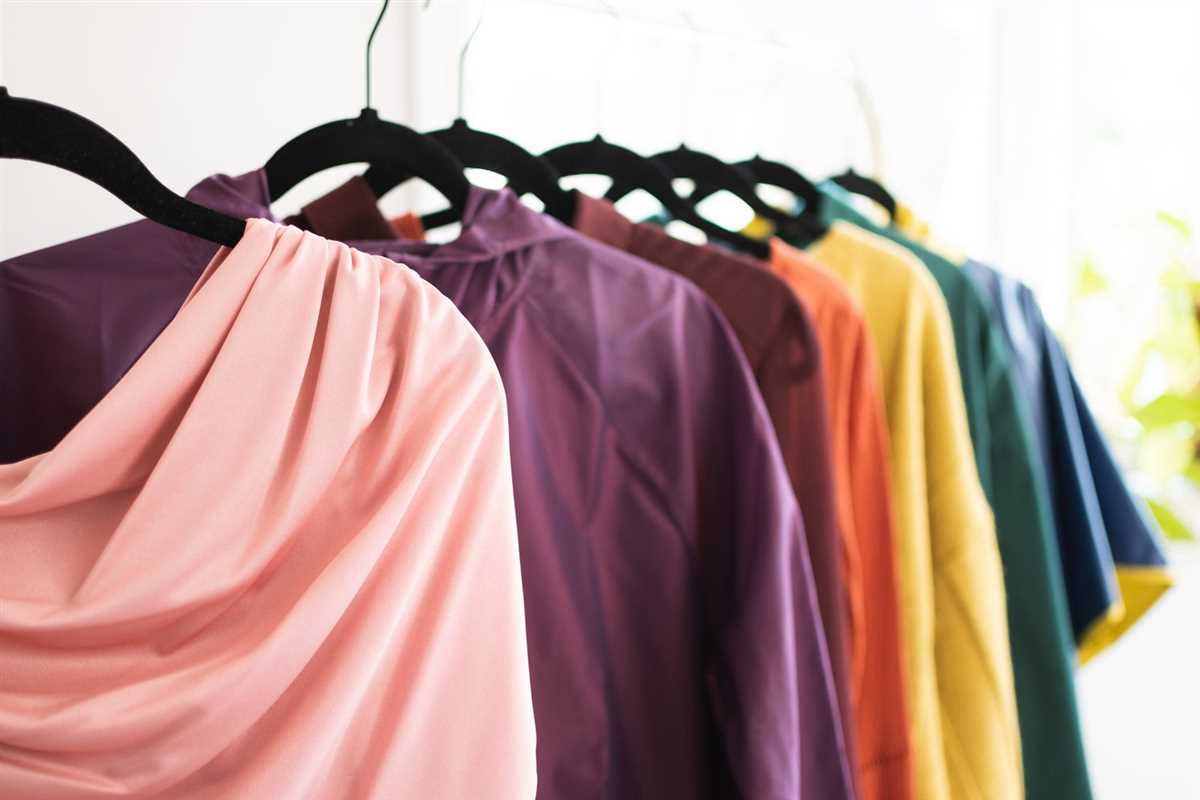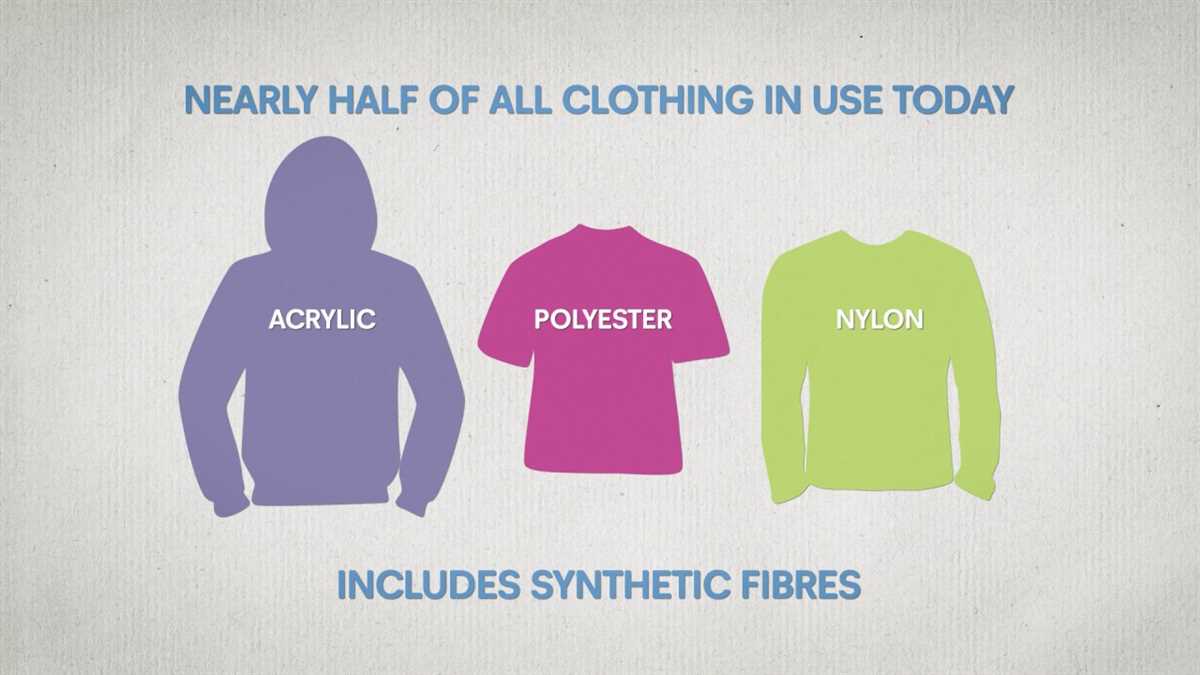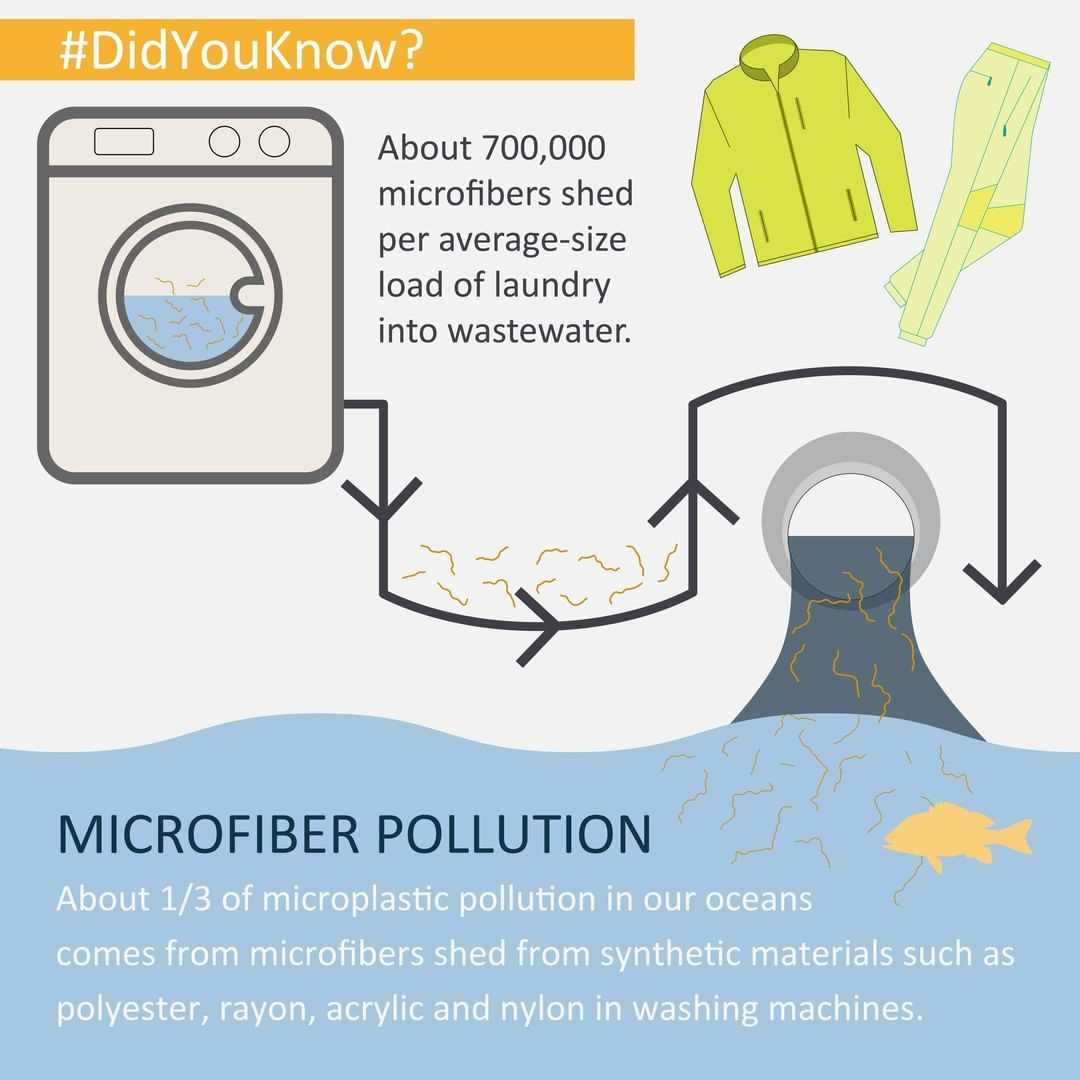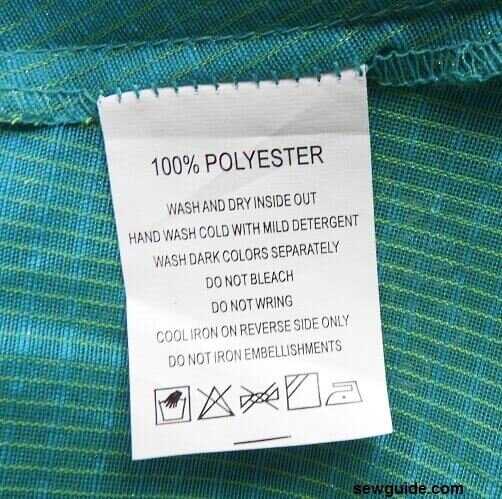




When it comes to the clothing we wear and the fabrics we choose for our daily wardrobe, it’s important to understand the different types of materials available. Synthetics, also known as synthetic fibers, have become an integral part of the fashion industry. From polyester to nylon, these man-made materials offer a wide range of benefits that are worth exploring.
One of the key advantages of synthetic materials is their durability. Unlike natural fibers such as cotton or silk, synthetics are designed to be long-lasting and resistant to wear and tear. This makes them ideal for everyday use, as they can withstand frequent washing and still maintain their shape and color. Additionally, synthetic materials are often more affordable than their natural counterparts, making them a popular choice for budget-conscious consumers.
Another benefit of synthetic materials is their versatility. From athletic wear to formal attire, synthetics can be found in a variety of clothing categories. They can be blended with other fibers to create fabrics with specific properties, such as moisture-wicking or UV protection. Furthermore, synthetics are often prized for their ability to be easily manipulated, allowing for innovative and unique designs that can’t be achieved with natural materials.
However, it’s important to note that synthetic materials do come with their own set of considerations. One of the main concerns is their environmental impact. Many synthetic fibers are derived from petroleum, which is a non-renewable resource. Additionally, the manufacturing process for synthetics can be energy-intensive and produce harmful emissions. As a result, there is a growing movement towards sustainable alternatives, such as recycled and bio-based synthetics, that aim to reduce the environmental footprint of the fashion industry.
While synthetic materials have their pros and cons, there’s no denying their widespread use and impact on the world of fashion. Whether you’re interested in understanding the benefits and drawbacks of synthetics or looking for tips on how to care for your synthetic clothing, this comprehensive guide will provide you with valuable insights and information.
The Rise of Synthetic Materials in Clothing
Synthetic materials have become increasingly popular in the world of clothing over the past few decades. These materials, which are made from man-made fibers, offer a range of benefits and have led to significant changes in the fashion industry.
Advantages of Synthetic Materials

- Durability: Synthetic materials such as polyester and nylon are known for their durability. They can withstand regular wear and tear, making them ideal for clothing that needs to last.
- Resistance: Synthetic materials often have resistance to wrinkles, stretching, and shrinking, which helps maintain the garment’s shape and appearance over time.
- Cost-effective: Synthetic materials are generally less expensive to produce compared to natural fibers like cotton or silk. This affordability makes clothing made from synthetic materials more accessible to a wider range of consumers.
- Easy care: Synthetic materials are often easy to care for, requiring minimal ironing or special cleaning instructions. They are commonly machine washable, saving time and effort in the laundry process.
- Performance: Many synthetic materials are designed with specific properties such as moisture-wicking, breathability, or water resistance. This performance-driven approach has led to the development of clothing suited for various activities and climates.
Impact on the Fashion Industry

The rise of synthetic materials has revolutionized the fashion industry in several ways:
- Increased availability: With the affordability of synthetic materials, a wide range of clothing options is now available to consumers. This has led to more choices and diversity in fashion trends.
- Fast fashion: Synthetic materials are often used in fast fashion due to their low cost and versatility. Fast fashion brands can quickly produce and offer new styles to keep up with the constantly changing trends.
- Sustainability concerns: Despite their advantages, synthetic materials have raised concerns about their environmental impact. Many synthetic fibers are derived from non-renewable resources and can take a significant amount of time to decompose.
- Innovation and creativity: The development of new synthetic materials has sparked innovation in clothing design. Designers can experiment with different textures, colors, and patterns to create unique and visually appealing garments.
The Future of Synthetic Materials
As technology advances, so does the potential for synthetic materials in the clothing industry. Researchers are exploring sustainable alternatives to traditional synthetic fibers, such as bio-based or recycled materials. The industry continues to strive for a balance between the advantages of synthetic materials and minimizing their environmental impact.
In conclusion, the rise of synthetic materials in clothing has brought numerous advantages and changes to the fashion industry. While they offer durability, performance, and affordability, concerns about sustainability remain. With ongoing research and innovative solutions, the future holds potential for more sustainable synthetic options in clothing.
The Evolution of Fabric: From Natural Fibers to Synthetics
Fabric has come a long way over the centuries, from being made exclusively from natural materials to the advent of synthetic fibers. This evolution has had a profound impact on the clothing industry and the way we live our lives.
Natural Fibers
For thousands of years, humans relied on natural fibers for their clothing needs. Materials such as cotton, silk, wool, and linen were harvested, spun, and woven into fabrics. These natural fibers offered breathability, comfort, and durability, but they were also limited in their properties and performance.
The Rise of Synthetic Fibers

In the early 20th century, scientists began experimenting with creating artificial fibers that could mimic or improve upon the qualities of natural fibers. This led to the development of synthetic fibers, which are man-made materials created through chemical processes.
One of the first and most well-known synthetic fibers is nylon, which was invented in the late 1930s. Nylon revolutionized the textile industry with its strength, durability, and elasticity. It quickly became a popular choice for stockings, parachutes, and various other applications.
Other synthetic fibers, such as polyester and acrylic, followed suit and gained popularity. These fibers offered advantages such as wrinkle resistance, quick-drying properties, and resistance to fading and shrinking. They also proved to be more cost-effective and readily available compared to natural fibers.
The Benefits and Drawbacks of Synthetics
Synthetic fibers have undoubtedly revolutionized the textile industry and offered numerous benefits. They are often more affordable, easier to care for, and can be engineered to possess specific properties such as moisture-wicking, stretch, or flame resistance. They also have a higher resistance to wrinkles, fading, and shrinking compared to natural fibers.
However, there are drawbacks to synthetic fibers as well. They are derived from non-renewable resources such as crude oil, and their production process can be energy-intensive and environmentally damaging. Additionally, some synthetic fibers have been criticized for their potential negative health effects and their non-biodegradable nature.
Conclusion
The evolution of fabric from natural fibers to synthetics has been a game-changer in the clothing industry. Synthetic fibers have provided countless benefits in terms of affordability, performance, and convenience. However, it is important to be aware of the environmental and health considerations associated with their production and use. As technology continues to advance, researchers are exploring more sustainable and eco-friendly alternatives, such as recycled synthetics and bio-based materials, to further improve the future of fabric.
Advantages of Synthetic Materials in Clothing
When it comes to choosing clothing materials, there is a wide range of options available. One popular category is synthetic materials, which are man-made fibers created through chemical processes. While natural fibers like cotton and wool have their own benefits, synthetic materials offer several advantages that make them a great choice for clothing.
1. Durability
Synthetic materials are known for their durability, making them perfect for everyday wear. Unlike natural fibers, such as cotton or silk, synthetic fibers are resistant to tearing, stretching, and wrinkling. This makes them ideal for clothing that needs to withstand regular use and frequent washing.
2. Low Maintenance
Synthetic materials are generally low maintenance, requiring less care compared to natural fibers. They are less prone to shrinking or fading when exposed to heat or sunlight, and they can be machine washed without worrying about damaging the fabric. This makes synthetic clothing convenient and time-saving for those with busy lifestyles.
3. Moisture Wicking

Many synthetic materials, such as polyester and nylon, have moisture-wicking properties. This means they are designed to draw moisture away from the body and allow it to evaporate quickly. As a result, clothing made from synthetic materials can help keep you dry and comfortable during physical activities or in hot and humid climates.
4. Lightweight
Synthetic materials are often lightweight, which makes them ideal for activewear and outdoor clothing. They do not add extra weight or bulk to your body, allowing for freedom of movement. Additionally, their lightweight nature makes them easy to pack and travel with, without taking up too much space in your luggage.
5. Versatility
Synthetic materials offer a wide range of properties that can be tailored to specific needs. For example, they can be made water-resistant or flame-retardant, making them suitable for various industries and purposes. This versatility makes synthetic materials a popular choice in both fashion and functional clothing.
| Advantage | Description |
|---|---|
| Durability | Synthetic materials are resistant to tearing, stretching, and wrinkling. |
| Low Maintenance | Synthetic materials are less prone to shrinking and fading and can be machine washed. |
| Moisture Wicking | Synthetic materials draw moisture away from the body and allow it to evaporate quickly. |
| Lightweight | Synthetic materials are lightweight and don’t add extra weight or bulk. |
| Versatility | Synthetic materials can be tailored to specific needs and purposes. |
Overall, synthetic materials offer several advantages in clothing, including durability, low maintenance, moisture-wicking properties, lightweight nature, and versatility. With these benefits, it’s no wonder that synthetic clothing has become a popular choice for many individuals.
Common Types of Synthetic Fabrics
When it comes to synthetic fabrics, there are several common types that are widely used in the clothing industry. These fabrics offer a range of benefits, including durability, versatility, and affordability. Here are some of the most common types of synthetic fabrics:
Polyester
- One of the most popular synthetic fabrics, polyester is known for its strong and durable properties.
- It is resistant to stretching, shrinking, and wrinkling, making it an ideal choice for clothing that requires frequent washing.
- Polyester is also quick-drying and moisture-wicking, making it suitable for activewear and sportswear.
Nylon
- Nylon is another commonly used synthetic fabric that offers excellent strength and durability.
- It is lightweight and has a smooth, silky texture, making it a popular choice for lingerie, hosiery, and swimwear.
- Nylon is also known for its elasticity, making it suitable for stretchy and form-fitting clothing.
Acrylic
- Acrylic is a synthetic fabric that is often used as a substitute for wool.
- It is lightweight and soft, with excellent insulating properties, making it ideal for cold-weather clothing.
- Acrylic is also resistant to shrinking and wrinkling, making it easy to care for.
Spandex

- Spandex, also known as Lycra or elastane, is a highly stretchable synthetic fabric.
- It is commonly used in activewear, swimwear, and form-fitting clothing.
- Spandex is known for its ability to retain its shape even after stretching, making it ideal for garments that require flexibility.
Rayon

- Rayon is a semi-synthetic fabric made from wood pulp.
- It has a soft and silky texture, similar to natural fibers like cotton and silk.
- Rayon is lightweight, breathable, and moisture-absorbing, making it suitable for warm-weather clothing.
Polypropylene

- Polypropylene is a synthetic fabric that is commonly used in baselayers and thermal clothing.
- It has excellent moisture-wicking and thermal properties, making it suitable for cold-weather activities.
- Polypropylene is also lightweight and quick-drying, ensuring comfort during intense physical activities.
These are just a few examples of the common types of synthetic fabrics used in clothing. Each fabric has its own unique properties and advantages, making it suitable for specific applications and preferences. When shopping for synthetic clothing, it is essential to understand the characteristics of these fabrics to choose the right option for your needs.
Polyester: The King of Synthetic Fibers
Polyester is one of the most popular and versatile synthetic fibers used in the textile industry. It is known for its durability, resistance to wrinkles, and ease of care. Polyester is made from petrochemicals, such as ethylene and propylene, which are derived from crude oil or natural gas.
Benefits of Polyester:
- Durability: Polyester is a strong fiber that is resistant to stretching and shrinking, making it ideal for garments that need to retain their shape.
- Wrinkle Resistance: Polyester has natural wrinkle-resistance, meaning clothes made from this fabric will stay smooth and crisp, even after washing and drying.
- Easy Care: Polyester garments are easy to clean and do not require special care instructions. They can be machine washed and dried without worrying about shrinkage or damage to the fabric.
- Quick Drying: Polyester has low water absorbency, which means that it dries quickly, making it perfect for activewear and swimwear.
Downsides of Polyester:
- Breathability: Polyester is not a breathable fabric, which means it can trap heat and moisture against the skin. This can lead to discomfort, especially in hot and humid conditions.
- Static: Polyester garments can generate static electricity, causing clothes to cling to the body.
- Environmental Impact: Polyester is a synthetic material made from non-renewable resources. Its production requires energy and releases greenhouse gases. Additionally, polyester garments shed microplastics when washed, which can contribute to environmental pollution.
Common Uses of Polyester:
- Apparel: Polyester is widely used in clothing, including shirts, pants, dresses, skirts, and jackets. It is often blended with other fibers, such as cotton or wool, to enhance its properties.
- Home Textiles: Polyester is commonly used in bedding, curtains, upholstery, and carpets due to its durability and stain resistance.
- Technical Textiles: Polyester is used in various technical applications, such as outdoor gear, sports equipment, and industrial fabrics, due to its strength and resistance to abrasion.
Caring for Polyester:
To care for polyester garments, follow these tips:
- Machine wash on a gentle cycle with like colors.
- Avoid using bleach or harsh detergents, as they can damage the fabric.
- Hang or lay flat to dry to prevent wrinkles and shrinkage.
- If ironing is needed, use a low heat setting or steam setting to avoid melting or damaging the fabric.
- Store polyester garments in a cool, dry place to prevent mildew and discoloration.
Conclusion:
Polyester is a versatile and widely used synthetic fiber that offers many benefits, including durability, wrinkle resistance, and easy care. However, it also has downsides, such as limited breathability and environmental impact. Understanding the properties of polyester can help consumers make informed choices about clothing and laundry care.
Nylon: The Versatile Synthetic Fiber
Nylon is a popular synthetic fiber that is known for its durability, strength, and versatility. It was first introduced in the 1930s by a research team at DuPont and quickly became a revolutionary material in the textile industry.
Properties of Nylon:
- Nylon is a lightweight fiber that is known for its strength and durability.
- It has a high resistance to abrasion, making it ideal for use in products that are subjected to heavy wear and tear.
- Nylon fibers have a smooth texture, which gives them a luxurious and silky feel.
- This synthetic fiber is known for its excellent elasticity, which allows it to stretch without losing its shape.
- It has a high melting point, making it resistant to heat and able to withstand high temperatures during the manufacturing process.
Applications of Nylon:
Nylon is used in a wide range of applications in various industries. Here are some common uses of nylon:
- Apparel: Nylon is commonly used in the manufacturing of clothing and accessories such as stockings, sportswear, swimwear, and lingerie. Its lightweight and breathable properties make it a desirable choice for activewear.
- Outdoor Gear: Nylon is often used in the production of outdoor gear and equipment such as tents, backpacks, sleeping bags, and ropes. Its strength and durability make it an ideal material for withstanding harsh weather conditions and heavy use.
- Automotive: Nylon is used in the automotive industry for various applications such as seat belts, airbags, car carpets, and upholstery. Its high heat resistance and durability make it a suitable choice for these components.
- Home Furnishings: Nylon is also used in the production of home furnishings such as carpets and rugs. It is highly resistant to stains and abrasion, making it a popular choice for high-traffic areas.
Maintenance of Nylon:
When it comes to caring for nylon garments, it is important to follow the care instructions provided by the manufacturer. However, in general, here are some tips for maintaining nylon clothing:
- Wash nylon garments in cold water to prevent shrinking or damage to the fabric.
- Avoid using bleach or fabric softeners, as they can weaken the fibers and reduce the garment’s lifespan.
- Hang nylon garments to dry or use the low heat setting on your dryer. High heat can cause the fibers to melt or become damaged.
- Avoid ironing nylon fabrics, as high heat can cause them to warp or shrink. If necessary, use a low heat setting or place a cloth between the iron and the garment.
In conclusion, nylon is a versatile synthetic fiber that offers a range of properties and applications. From clothing and outdoor gear to automotive components and home furnishings, nylon has become an essential material in many industries.
Rayon: The Natural Synthetic Fiber
Rayon is a versatile and widely used synthetic fiber that is often referred to as a “natural synthetic.”
Despite being classified as a synthetic fiber, rayon is derived from natural materials such as wood pulp or bamboo. The process of turning these natural materials into a usable fiber involves several chemical treatments, hence the synthetic classification.
Rayon has many desirable qualities that make it a popular choice for clothing and other textile applications. Some of its key features include:
- Softness: Rayon has a smooth and silky texture, making it comfortable to wear.
- Breathability: Unlike some other synthetic fibers, rayon is breathable and allows air to circulate, making it suitable for summer clothing.
- Absorbency: Rayon has excellent moisture absorption capabilities, which helps keep the wearer dry.
- Drapability: Rayon fabric drapes well and has a beautiful flow, making it ideal for garments that require a fluid silhouette.
- Dyeability: Rayon can be easily dyed in a wide range of colors, providing endless possibilities for designers.
While rayon offers many advantages, there are also some considerations to keep in mind when using and caring for rayon garments:
- Sensitivity to heat: Rayon can be damaged by high temperatures, so it is important to follow the care instructions and avoid exposing rayon garments to excessive heat.
- Shrinkage: Rayon has a tendency to shrink when washed or dried at high temperatures, so it is best to wash rayon garments in cold water and air dry them to avoid any shrinkage.
- Wrinkling: Rayon can wrinkle easily, so it may require ironing or steaming to maintain a smooth appearance.
Overall, rayon is a highly versatile synthetic fiber that combines the best of both natural and synthetic worlds. Its softness, breathability, and drapability make it a popular choice for a wide range of clothing and textile applications. However, proper care should be taken to ensure the longevity and appearance of rayon garments.
FAQ
What are synthetic materials in clothing?
Synthetic materials in clothing are man-made fabrics that are created using chemical processes. These materials are designed to mimic the properties of natural fabrics, such as cotton, wool, or silk.
What are some examples of synthetic materials in clothing?
Some examples of synthetic materials in clothing include polyester, nylon, acrylic, spandex, and rayon. These fabrics are often used in the production of activewear, swimwear, and outdoor gear.
What are the advantages of using synthetic materials in clothing?
There are several advantages to using synthetic materials in clothing. They are often more durable and resistant to wear and tear compared to natural fabrics. Synthetic fabrics are also less prone to wrinkling and shrinking, making them easier to care for. Additionally, synthetic materials can be engineered to have specific properties, such as water resistance or moisture-wicking capabilities.
Are there any disadvantages to using synthetic materials in clothing?
While synthetic materials have their advantages, there are also some disadvantages to consider. One common issue is their tendency to trap heat, which can make them uncomfortable to wear in hot weather. Synthetic fabrics can also be less breathable compared to natural fabrics, which may cause sweating and odour. Furthermore, the production of synthetic materials often involves the use of chemicals and fossil fuels, which can have negative environmental impacts.
How should synthetic clothing be laundered?
Synthetic clothing can typically be laundered in a washing machine using cool or warm water. It is recommended to turn the garment inside out and use a gentle cycle to avoid stretching or damaging the fabric. It’s best to avoid using bleach or fabric softener, as they can break down the fibres. After washing, synthetic clothing should be air-dried or tumble-dried on a low heat setting to prevent shrinkage.
What are synthetic materials in clothing?
Synthetic materials in clothing are man-made fabrics that are created through chemical processes. These fabrics are specifically designed to mimic and replicate the properties of natural materials, such as cotton, silk, and wool. Common examples of synthetic materials include polyester, nylon, acrylic, and spandex.
What are the advantages of using synthetic materials in clothing?
There are several advantages of using synthetic materials in clothing. Firstly, synthetic materials are often more affordable than natural materials, making them accessible to a wider range of consumers. Secondly, many synthetic materials have excellent durability and resistance to wear and tear, allowing garments to last longer. Additionally, synthetic fabrics are often lightweight, quick-drying, and easy to care for, making them popular choices for activewear and outdoor clothing.















